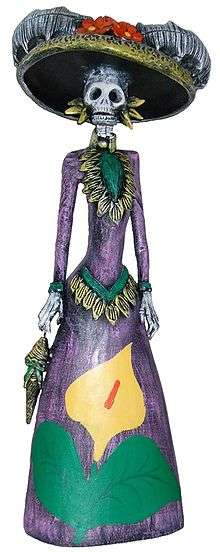La Calavera Catrina
La Calavera Catrina or Catrina La Calavera Garbancera ('Dapper Skeleton', 'Elegant Skull') is a 1910–1913 zinc etching by the Mexican printmaker, cartoon illustrator and lithographer José Guadalupe Posada.[1] She is offered as a satirical portrait of those Mexican natives who, Posada felt, were aspiring to adopt European aristocratic traditions in the pre-revolution era. La Catrina has become an icon of the Mexican Día de Muertos, or Day of the Dead.
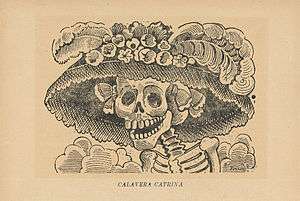

The zinc etching depicts a female skeleton dressed only in a hat. Her chapeau en attente is related to European styles of the early 20th century. The original leaflet describes a person who was ashamed of her indigenous origins and dressed imitating the French style while wearing much makeup to make her skin look whiter.[2] This description also uses the word garbancera, a nickname given to people of indigenous ancestry who imitated European style and denied their own cultural heritage.[3][4]
Cultural importance
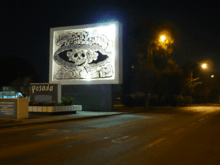
"La Catrina has become the referential image of Death in Mexico, it is common to see her embodied as part of the celebrations of Day of the Dead throughout the country; she has become a motive for the creation of handcrafts made from clay or other materials, her representations may vary, as well as the hat." – J.G. Posada[3]
While the original work by Posada introduced the character, the popularity of La Calavera as well as her name is derived from a work by artist Diego Rivera in his 1947 completed mural Sueño de una Tarde Dominical en la Alameda Central (Dream of a Sunday afternoon along Central Alameda).
Rivera's mural was painted between the years 1946 and 1947, and is the principal work of the "Museo Mural Diego Rivera" adjacent to the Alameda in the historic center of Mexico City. It measures 15 meters long and it stood at the end of Alameda Park. The mural survived the 1985 earthquake, which destroyed the Del Prado hotel, and was later moved across the street to the Museo Mural Diego Rivera, built after the earthquake for the purpose of housing and displaying Rivera's restored mural.[5]
Artistic subtext
Image

Rivera's mural depicts a culmination of 400 years of Mexico's major figures, which include himself, Posada, and Frida Kahlo. Rivera took inspiration from the original etching and gave Calavera a body as well as more of an identity in her elegant outfit as she is poised between himself and Posada. The intent seemed to be to show the tradition of welcoming and comfort the Mexicans have with death and especially the identity of a Lady of the Dead, harking back to the heritage of the Aztec goddess Mictecacihuatl. As explained by curator David de la Torre from the LA Plaza de Cultura y Artes, a Mexican-American museum and cultural center in Los Angeles, California, US, Catrina has come to symbolize not only Día de Muertos and the Mexican willingness to laugh at death itself, but originally Catrina was an elegant or well-dressed woman, so it refers to rich people,[5] de la Torre said. "Death brings this neutralizing force; everyone is equal in the end. Sometimes people have to be reminded of that."
Culture
The culture of La Calavera has ties to political satire and is also a well-kept tradition as the original was inspired by the polarizing reign of dictator Porfirio Díaz. Díaz is lauded for modernizing and bringing financial stability to Mexico, but he also led his government in repression, corruption, and excess, and had an apparent obsession with European materialism and culture. Christine Delsol writes: "Concentration of fantastic wealth in the hands of the privileged few brewed discontent in the hearts of the suffering many, leading to the 1910 rebellion that toppled Diaz in 1911 and became the Mexican Revolution."[5]
Social Classes
She also symbolizes the contrasts between the upper and lower classes, for times were cruel. The social classes were extremely segmented and the highest class was the most fortunate, enjoying many privileges; in contrast, the lower classes were nearly invisible. To explain and rescue the folklore of honoring the memory of those who have died, while showing this off to high society, José Guadalupe Posada made caricatures of Death, one of these drawings being the famous Calavera with an elegant hat, though only representing the head and bust with a sophisticated and skeletal essence.[3]
Links to Mesoamerica
Aztecs
The calavera's ties to the past heritage of the Aztecs can be seen in various ways. The indigenous culture of skulls and the death-goddess Mictecacihuatl is common in pre-Columbian art. Lady of the Dead, Mictecacihuatl, was keeper of the bones in the underworld, and she presided over the ancient month-long Aztec festivals honoring the dead. Since the pre-Columbian era, Mexican culture has maintained a certain reverence towards death,[6] which can be seen in the widespread commemoration of the Day of the Dead.[7] With Christian beliefs superimposed on the ancient rituals, those celebrations have evolved into today's Day of the Dead.[5]
Spain
As for the Spanish heritage (the death-orientation of the monastic orders, Dance of Death, and memento mori traditions), it blended with the average Mexican's stoic, but far from humorless, view of death.1 Some find La Catrina to have closer ties to the Dance of Death than to the possible origins of the calavera in the art of ancient Mesoamerica. La Calavera differs markedly from the rigid sobriety of skulls carved by the Aztec or images of decomposing corpses depicted by the ancient Maya. In prints and various other art forms associated with the Day of the Dead—everything from papier-mâché to papel picado (perforated paper) to sugar and chocolate—images of the calavera are unmistakably humorous. The skeletons, often dressed in finery, move playfully and smile widely. In some ways, these animated figures are much closer visually to the European Dance of Death motif in which limber skeletons lead, lure, or drag unwitting mortals to their ends.[8]
Mexico
Though these interpretations seem to ignore the full relationship that the Mexicans have with death, as well as the macabre humor that ties to the cycle of life, death and ceremony that the Aztecs had, it should be understood that few countries pay homage to death the way Mexico does; offerings, songs, respect and humor are all common Mexican expressions towards death.[9] The European ties are there both for comic effect as well as depicting the symbolic shell that Europe cloaked Mesoamerica in, but the native bones still lie within.
Folk art
Purist
La Calavera Catrina today can be found in her more traditional form both in drawn works as well as sculptures made out of Oaxacan wood carvings, papier-mâché sculptures, majolica pottery, and Barro negro black clay pottery. She is also coupled with male skeletons.
Costume
Dressing as a "Catrina" is a popular costume in Day of the Dead celebrations in Mexico. Catrinas typically feature "sugar skull" make-up.[10]
- Day of the Dead, circa 2014.
.jpg) Woman dressed as a Catrina
Woman dressed as a Catrina.jpg) Girl dressed as a Catrina
Girl dressed as a Catrina.jpg) A Catrina
A Catrina.jpg) Three children dressed as Catrinas
Three children dressed as Catrinas.jpg) Woman dressed as a Catrina
Woman dressed as a Catrina
In popular culture
- Works such as the screen print Sun Mad (Raisins) by Ester Hernández in the Smithsonian American Art Museum show the influence of Posada's earlier vision.[11] The same might be said of the cover for Los Lobos' album La pistola y el corazón, which depicts a pistol toting Catrina in a couple's embrace.
- A character based on La Calavera appears as a protagonist in the 2014 computer-animated film The Book of Life, where she is named "La Muerte" and is the queen of the deceased who are remembered by the living. She is referred to in the Latin American Spanish dub as "La Catrina".[12] See footnote.
- Two educational video series, La Calavera and La Calavera: El úlitmo secreto, were filmed in Mexico by Pearson Education, and include various program components.[13] Both videos integrate language proficiency with culture, and follow the journey of Jamie González as she searches for the secrets of her mysterious great-grandmother.[14]
- In the MMORPG World of Warcraft, during the first and second days of November, a Day of the Dead Celebration is held among the largest Capital Cities of the game. Each city has a Calavera, represented as a dancing female undead NPC dressed in a mariachi outfit. If the player dances with her, his or her player character will also take the appearance of an undead character with a similar outfit.
- In the Pathfinder Roleplaying Game, creatures called Calaveras painlessly welcome into the afterlife those who cannot accept death.[15] They are similar in appearance to La Catrina, wearing a festive dress and carrying a bouquet of flowers.
- The video game Need for Speed: Payback features a crew leader by the name of "La Catrina" as the leader of her crew "Graveyard shift" and one of the first bosses you encounter. Her motto says "When you ride a Hundred Miles an hour, Every decision is Life and Death".[16]
Gallery
 A Catrina inspired by María Félix as part of an ofrenda on the day of the dead festivities at San Ángel in November 2014
A Catrina inspired by María Félix as part of an ofrenda on the day of the dead festivities at San Ángel in November 2014 A Catrina inspired by Selena during celebrations of Day of the Dead at Hollywood Forever Cemetery, Los Angeles
A Catrina inspired by Selena during celebrations of Day of the Dead at Hollywood Forever Cemetery, Los Angeles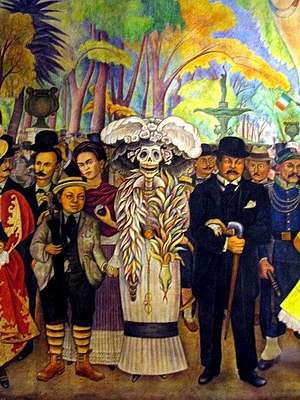 Center of Diego Rivera's wide mural Sueño de una Tarde Dominical en la Alameda Central (Dream of a Sunday Afternoon in the Alameda Central)
Center of Diego Rivera's wide mural Sueño de una Tarde Dominical en la Alameda Central (Dream of a Sunday Afternoon in the Alameda Central)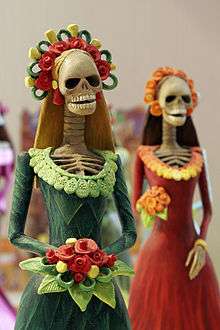 Modern representations of Catrina at the Museo de la Ciudad, León, Guanajuato, Mexico
Modern representations of Catrina at the Museo de la Ciudad, León, Guanajuato, Mexico Image done in colored sawdust for Día de Muertos
Image done in colored sawdust for Día de Muertos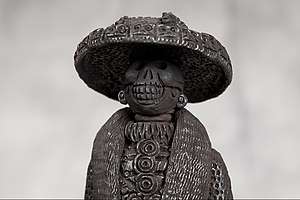 Detail of a Catrina figure in Barro negro pottery by artisan Carlomagno Pedro Martinez
Detail of a Catrina figure in Barro negro pottery by artisan Carlomagno Pedro Martinez- La Catrina in China Poblana dress, by Rodofo Villena Hernandez in Puebla
See also
References
- "Jose Guadalupe Posada, Calavera Catrina (Dapper Skeleton)". ArtofthePrint.com.
- "La Catrina". Copal, Mexican Folk Art at its best Online. Retrieved 2018-10-27.
- "La Catrina – The woman of Mexico". Rocky Point 360. 2012-10-30. Retrieved 2018-10-27.
- "Catrina La Calavera Garbancera is the icon of Día de los Muertos". New York Latin Culture Magazine. 2018-09-25. Retrieved 2018-10-27.
- Delsol, Christine; SFGate, Special to (25 October 2011). "La Catrina: Mexico's grande dame of death". SFGate.
- Araujo Peña, Sandra Alejandro; Barbosa Ramírez Marisela; Galván Falcón Susana; García Ortiz Aurea; Uribe Ordaz Carlos. "El culto a la Santa Muerte: un estudio descriptivo" [The cult of Santa Muerte:A descriptive study]. Revista Psichologia (in Spanish). Mexico City: Universidad de Londres. Retrieved 2009-10-07.
- Ramirez, Margaret. "'Saint Death' comes to Chicago". Chicago Tribune. Chicago. Retrieved 2009-10-07.
- "Art Through Time: A Global View - La Calavera de la Catrina". www.learner.org.
- "Yahoo!". celebra.aollatino.com.
- Devash, Meirav. "5 Things to Know Before Doing Dia de Los Muertos Makeup". Allure. Retrieved 2018-10-07.
- "¡Del Corazón! / American Art". 2.americanart.si.edu.
- "The Book of Life (2014 film), Trivia". IMDb.com.
In the Spanish dubbing of the movie, La Muerte is called "La Catrina", this is obviously "Posada's Catrina" a popular iconic skeletal lady that has become associated with the festivities of the Día de Muertos. Her main attribute is a gorgeous hat. In the movie, the modern Mexican icon (La Catrina) and the classic icon (Lady Death), are fused in a single role as the ancient Mayan goddess of death, ruling over one of the lands of the dead.
- "AP Honors and Electives Curriculums and Textbooks - Pearson". www.pearsonschool.com.
- "AP Honors and Electives Curriculums and Textbooks - Pearson". www.pearsonschool.com.
- Stephen., Radney-MacFarland; K., Reynolds, Sean; Dennis., Baker; Alexandur., Alexandrov; Jason., Bulmahn; Gary., Gygax; 1947-2009., Arneson, Dave (2013-01-01). Pathfinder roleplaying game : Bestiary 4. Paizo Pub. ISBN 9781601255754. OCLC 863052391.CS1 maint: numeric names: authors list (link)
- Arts, Electronic (8 November 2017). "Graveyard Shift - Street Leagues - Need for Speed Payback". www.ea.com.
External links
![]()
